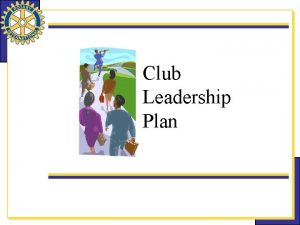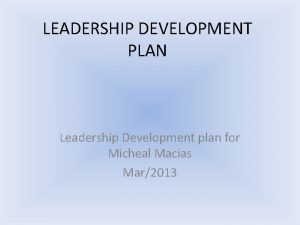90 Day Leadership Plan 90 Day Leadership Plan








- Slides: 8

90 Day Leadership Plan

90 Day Leadership Plan Execution A framework with directs, peers and stakeholders that facilitates: • Assessment of current state of xxx business: Sustain success, Turnaround, Realign, Start-up • Accelerated learning: Climb the organizational & geographic learning curve quickly through a programmatic approach • Alignment of strategy to situation through input: • People: Understand the team; perceptions of key stakeholders, identify quick wins and assemble a plan to build and motivate a high performing team based on the current state. • Customer & Partner: Understand xxxxxxs’ customer & partner lifecycle, build a plan to deliver the most rewarding engagement and highest satisfaction. • Operations: Identify current execution challenges, seek quick improvement wins and what is needed to get to the most efficient and predictable state. • Growth Plan: Understand existing strategy, evolve or build a multi-year plan that spans individual contributors and mgmt team to drive xxxxxxs’ xxx growth • Execution of plan: Full stakeholder review at 30, 60, 90 days to achieve ongoing insight Growth and alignment Ops Partner Customer People

People Goal: Ascertain morale, status of the teams/people, past performance, culture and seek quick wins • Introduction to the xxxxxxs xxx business. 30/60 • • • 90 • All hands introduction (multiple to accommodate time zones if required) • Field tour: 1: 1 introduction/Q&A with each team (geographic considerations) & departing leader to seek direct feedback, get the pulse of the team: morale, common themes (positive & negative), sense of urgency, speed of cultural change. • Skip level connection meetings to begin building trust and to seek input Implement vitality curve review with mgmt team mapped by performance and tenure • Identification of high potentials, performance issues, potential change agents. • Identify key hiring issues and review recruitment plan Execute 1: 1 s with direct reports reviewing past/present performance, career path, motivation, morale, goal setting. • Partner with HR and the departing leader to build management team vitality curve (tenure, performance). • Review succession plans. • Execute external assessment (i. e. Predictive index) to facilitate initial team building and understanding of team dynamics. Identify key relationships in xxxxxxs (product support, partner groups, selling partners). • Organize networking 1: 1 s across organization (90 day timeline) Assessment of existing communications vehicles and culture to facilitate ongoing bi-directional flow • Example: Monday morning mail, weekly/quarterly calls, blogs, etc) Review existing rewards (i. e. Compensation, incentives) and recognition (i. e. Celebrating wins, birthdays) systems/culture Engage HR partner for full review: • Existing budgets (training, morale), training programs (LMS, etc), performance tools, new hire on-boarding, mentor programs. • Current state review of top & bottom (i. e. Identified high potentials, performance issues) and review how xxxxxxs measures work health (management feedback, employee opinion polls) Formalize the high performing xxx plan • Implementation of key xxx themes (i. e. Net attractor of talent, great team, cross group) aligned with corporate vision and values • Understand team rhythm to people reviews, performance management, high potential management, communications model (1: 1 s at all levels, skip level pulse 1: 1 s, portals, email, voicemail, etc. ) • Identification of changes that will lead to the highest of performing teams while delivering momentum building wins Growth Ops Partner Customer People

Customer & Partner Goal: Ascertain how xxxxxxs engages customers and partners at each stage – seek quick wins • Understand how xxxxxxs views customer engagement 30/60 90 • Sales force: Sales stage process, market segmentation, organizational structure, cross team collaboration with the customer (marketing, partner organizations), communication model (i. e. The lifecycle of customer communication such as strategy updates) • Marketing: Planning, field engagement model, measurement, communication model, execution • Product development & evolution: Customer feedback stages, implementation assessment and modelling • Operations: Identify customer triggers (i. e. satisfaction survey, end of contract or utilization flags (T-6 process), other processes). Understand support process (identification, understanding, resolution) • Review customer satisfaction strategy • Measurement and tracking, competitive positioning, sales force compensation, execution, feedback mechanisms (i. e. askus@) and field plans (individual contributor, manager, director) • Understand customer value proposition by segment (i. e. value prop, differentiators, pitch by segment) and expand network • Quickly execute a range of customer & partner meetings (dissatisfied, satisfied) to gather first hand feedback. • Leverage MS, Comm. Sector and Telco relationships in xxx to quickly expand regional network. • Seek key leverage opportunities into community (i. e. GSMA? ) • Review the partner strategy • Internal support and work with partners (reseller, external partners (OEM, provider of service) • Sales force operations with partners (i. e. Joint marketing, joint engagement) Formalize strategy to drive the highest levels of satisfaction • Implementation of key customer & partner themes (i. e. Achieving NSAT of X, X share against key competitors) • Review/implement operational rhythm to review customer & partner satisfaction based on key triggers • Examples: contract, survey, interaction) • Customer & partner plan: Leverage outputs of first 60 days to evolve the customer strategy and clearly communicate across the business Growth Ops Partner Customer People

Operations Goal: Understand xxxxxxs’ business rhythm, levels of automation, flexibility and current state while building momentum. 30/60 90 • Review current state of the business • Achievement against budgets (multi-year), action plans, trends and appropriate operational data. • Review sales force planning process • Territory growth planning, quota setting, market segmentation, goal setting • Review current operational reporting model and metrics: • What metrics does xxxxxxs use to measure success? Customer sat, product reporting, revenue, margin, share, scorecard implementation. • Understand budgeting model (Regional P/L, quarterly operational budgets, etc. ) and flexibility • Understand operational rhythm: • Forecasting and metrics review (daily-weekly-monthly – by level? ) • Sales force business and growth plans review rhythm • Review sales force support infrastructure • Sales tools & strategy, what is the plan? • Review operational integration cross group: • Orchestration with finance, HR, products, marketing and selling partners (i. e. Enterprise), rhythm of review Formalize plan to deliver operational excellence considering current state • Highly dependant on xxx existing state. Implementation of operational rhythm and structure which provides a single view of business state while maximizing field customer time. Growth Ops Partner Customer People

Growth plan Goal: Understand xxxxxxs’ existing growth strategy, stakeholder/matrix strategies while identifying quick wins 30/60 • Review existing strategy and growth (plans at all levels • Territory plans, manager growth plans, director growth plans, organizations growth plan) • What are the key changes to differentiate and beat market? • Review rhythms for planning and strategy • Budget setting, market assessment phases, capital planning. • Review key stakeholder strategies • Marketing, partner sales organizations, product and input on existing business strategy • Review key external inputs and market opportunity • Assessments, market reviews, industry data by region/country • Identify mechanism for team input into evolving strategy • Vision setting exercises, central input, virtual teams, leverage high potentials) Clear timeline to building a multi-year xxx plan that supports and enhances the global plan 90 • Support or build a process to formulate a plan that scales from individual contributors, line management to cross organization. • Identify best way to articulate vision – strategy plan ; achieve stakeholder and team support – input – acceptance. • Identify best vehicle to track and communicate plan Growth Ops Partner Customer People

Personal Integration Plan Goal: Quickly integrate into the xxxxxxs corporate culture and build local knowledge/network • Quick ramp through structured integration into the business (90 day plan) • Active field knowledge gathering (Skip levels, 1: 1 s) • Regular business, strategy reviews with key stakeholders • Personal development review and coaching • Leverage industry and regional network to integrate • Leverage xxxxxxx network (Singapore, China, HK, etc) and Telco network • Learning plan • Seek stakeholder input to quickly build a structured learning plan that facilitates integration • Local cultural mentorship (identified) • xxxx Executive Program • Strategic use of executive coach (Peer review at 120 days)

Uploaded in support of http: //leadingasalestransformation. com















